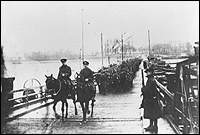|


|

|

1918—End of the War
The regiment spent the first two months of 1918 in the trenches at Passchendaele and
digging the Brandhoek Line. In March, they were back in the front lines during the Battle
of Lys and the defence of Bailleul where high casualties were endured once more. This
was the regiment’s last battle as part of the 29th Division. The following month
the regiment was formally withdrawn from service due to its depleted ranks.
On its departure from the 29th Division, the regiment was commended by Major
General D. E. Cayley as “a splendid fighting unit” that had “consistently maintained the
highest standards of fighting efficiency and determination.” He further stated “They can
look back on a record which they and their fellow countrymen have every right to be
proud” (Facey-Crowther 42). A further honour was the assignment to guard General Haig’s
headquarters at Montreuil.
The Newfoundlanders were at Montreuil for the spring and summer of 1918. By
mid-September 1918 the regiment once again had sufficient numbers to return to action.
They were assigned to the 28th Infantry Brigade of the 9th (Scottish) Division
and were back in the trenches east of Ypres at Ledeghem. It was north of Ledeghem that
Sergeant Thomas Ricketts earned the regiment’s only Victoria Cross.
It was also during this battle that the Newfoundlanders received perhaps their
greatest praise. When Brigadier-General Freyberg of the 88th discovered that the
Newfoundlanders were holding his left flank, he said, “Thank-God, my left flank is
safe . . . now for my right.” Newfoundland journalist, Dr. John Alexander
Robinson, wrote:
|
The Royal Newfoundland Regiment received many tributes of praise during the war
from imperial and distinguished quarters, but [Brigadier-] General Freyberg’s involuntary words
will, I think, appeal most as the greatest of all, greater even than the ‘better than the
best,’ which however grateful to our pride in the gallant sons of our loved land, savours
of extravagance (Nicholson 486–493).
|
In three years of combat the regiment had acquired a well-deserved reputation for hard
fighting and tenacity under fire.
In October 1918, as a part of the liberating forces that passed through Belgium,
the regiment was involved in its final battle at Ooteghem-Inghem Ridge. They were
relieved for the last time on October 26th, when depleted ranks and lack of resources
caused the regiment to be withdrawn effectively from active service.
Royal Newfoundland Regiment crossing the Rhine into Germany, December 13, 1918.
Pictured
are Capt. Arthur Raley (left) and Lt. Col. A. E. Bernard (right).
Courtesy of the Provincial Archives of Newfoundland and Labrador (PANL VA-28-146), St. John’s,
Newfoundland.
 (18 Kb)
(18 Kb)
|
 |

|
When the armistice was signed on November 11, 1918, the regiment was at Cuerne
in Belgium. The Royal Newfoundland Regiment ended the war as one of the most
decorated units in the British Army. The regiment now switched its concerns to
demobilisation and returning home.

|

|
 |